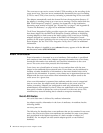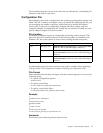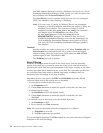
The boundaries between events in the cache file are indicated by a terminating ^A
character at the end of each event.
Configuration File
Most adapters come with a configuration file containing configuration options and
filters. This file is read by an adapter when it is started. By modifying this file, you
can reconfigure an adapter at anytime, without having to modify the adapter
source code. To have your configuration changes take effect, simply stop and
restart the adapter. A configuration file usually has an extension of .conf; see each
specific adapter chapter for exact file names.
File Location
By default, an adapter expects its configuration file (along with its format, CDS,
and error files) to be located as shown in the following table. For Windows and
Windows NT, the syntax shown is correct when running the bash interpreter.
Adapter Type Node Type Location
TME Managed node $BINDIR/TME/TEC/adapters/etc/ or /etc/Tivoli/tecad/etc
(which is a link to the TME adapter directory)
Endpoint $LCFROOT/bin/$INTERP/TME/TEC/adapters/etc or
/etc/Tivoli/tecad/etc (which is a link to the TME adapter
directory)
non-TME Not applicable path/etc where the adapter was manually installed or
/etc/Tivoli/tecad/etc (which is a link to the TME adapter
directory)
For information about directory structures and system variables (those beginning
with $), see the Tivoli Management Framework Planning for Deployment Guide.
File Format
Each non-blank line that does not begin with the comment sign (#) is of one of the
following forms:
v To specify configuration options:
keyword=value
v To specify event filters:
Filter:CLASS=class_name;attribute=value;
v To specify event buffer filters:
FilterCache:CLASS=class_name;attribute=value;
Example
#
# Communication Parameters
#
ServerLocation=ravel
ServerPort=5529
#
# Event Filters
#
Filter:Class=disk_event
Filter:Class=Su_Success;origin=126.32.2.14
Keywords
Keywords use the following format: keyword=value
Chapter 1. Understanding Adapters 9


















